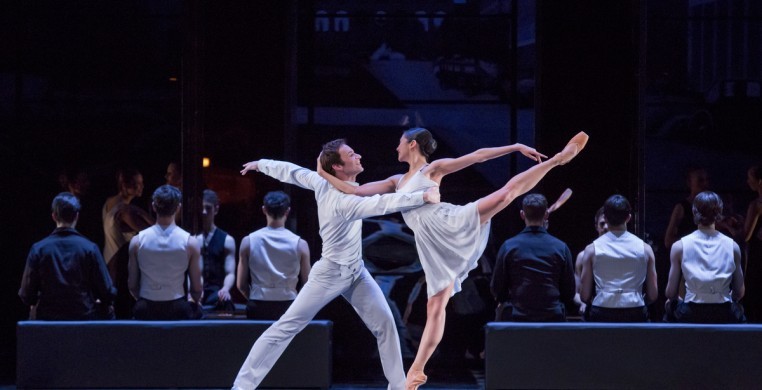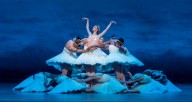The Joffrey Ballet’s U.S. premiere of Krzysztof Pastor’s Romeo and Juliet (2008), through May 11 at the Auditorium Theater, integrates ballet and historic film footage with the lush Prokofiev score to set the story against a backdrop of fascism and world conflagration.
Family feuds have stoked the fires of human conflict since the beginning of recorded history. Pastor’s leap from family feud to world war makes its point repeatedly as the young lovers time- travel across the 20th century, but Shakespeare’s story remains intact and as poignant as ever.
Act One takes place in the 1930’s of Mussolini’s fascist regime with the dancers lit in relief in front of filmed scenes of Rome under the dictator’s rule. Bert Dalhuysen’s lighting effectively integrates the movement on stage and on the screen, allowing the analogy to register right at the top. Tatyana Van Walsum’s period costuming puts us in historic 30’s austerity, with opening movement identifying the various social strata and family affiliations of the community, Montagues and Capulets color-coded in white and black.
Pastor’s choreography gets inside the language and flavor of Shakespeare’s characters and uses the music’s high drama, searing passion, stark melodic and rhythmic contrasts, and dissonance to reflect Shakespeare’s extremes of light and dark, levity and tragedy. The Chicago Philharmonic, under the masterful baton of Joffrey music director Scott Speck, matches the dancers’ virtuosity with a rendering of Prokofiev so rich and vibrant that it commanded as much of the story-telling from the orchestra pit as the dancing did on stage.
Pastor nails the characters with movement motifs that make them instantly recognizable--the bold and sassy Mercutio (Yoshihisa Arai), the peace-loving Benvolio (Alberto Velasquez), and the reticent Romeo (Rory Hohenstein)--providing a physical subtext that does the work of unspoken lines without relying on mime. He makes inventive use of Prokofiev’s rhythms to give the jaunty trio some spicy kicks, pirouettes, jetes and tours that show both their wit and dancing brilliance.
Simmering hatred between clans erupts in small choreographed fist-fights that spare no stylization to give a sense of real danger to the confrontations. Pastor builds suspense by providing the dancers with a movement “script” that insists on emotional volatility and vulnerability. He uses Prokofiev’s weighty “March of the Capulets and the Montagues” for a quartet of police to intervene, periodically carving their authoritarian rigidity in angular kicks and struts right through the middle of the tension, threatening anyone who crosses the line.
The lithe and lyrical April Daly triumphs in off-center casting as an older, stately Lady Capulet, showing a depth of tenderness and volumes of motherly concern for her vivacious daughter, Juliet (Christine Rocas). In a stroke of casting economy and dramatic justification, Pastor does away with Juliet’s nurse.This allows for expanded development of Juliet’s relationship with her mother, played out in a fascinating duet of anguish and consolation, sharp twists, and embraces. Rocas’s adolescent enthusiasm, square-shouldered innocence and glowingly beautiful dancing give Juliet’s youthful ardor refreshing authenticity.
The supremely fine dancer/actor Fabrice Calmels is commanding as Capulet, exposing a multi-layered, sympathetic side to the character. Although we only get fleeting glimpses of his wonderful dancing, his duet with Juliet stands out.
The story jumps to the prosperous post-war 1950’s for Act Two, where the unique power of dance to tell a story is gloriously apparent in the street scene between Tybalt and Mercutio. Arai’s smart-aleck Mercutio never had more fun cutting a bully down to size as when he thumbs his nose at Temur Suluashvili’s snotty Tybalt, but fun and games turn on a dime and the inevitable inciting incident, Mercutio’s death, sends the drama on its tailspin toward tragedy.
The story we all know plays out it’s tragic conclusion in the 1990’s, with Friar Lawrence trying desperately to secure the young lovers’ escape from families that would never condone their union. This segment, while emotionally wrenching, has the least engaging choreography, relying too heavily on the music to sustain the parents’ grieving.
How the story travels through time, when and where this archetypal tragedy takes place, can have as profound an impact as the medium through which it is told. Setting Act One in fascist Italy makes a justifiable point, but that theme fades once we enter Act II. It’s hard to tell just what point Pastor is making with the time shifts into the 50’s and 90‘s, other than that the story continues on through the ages.
Pastor, and the Joffrey Ballet, have given us a magnificently danced story that captures the dramatic essence of Romeo and Juliet, but the attempt to layer more timely relevance for a modern day audience becomes an overly repetitive and sometimes peripheral element. As with all modern era retellings of Shakespeare, one has to ask if time-traveling enhances the eloquence of Shakespeare’s allegory, or merely adds novelty where none is needed.
Lynn Colburn Shapiro, May 4, 2014


